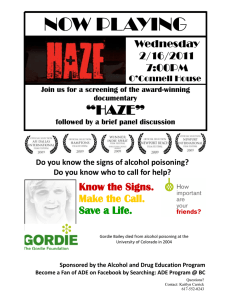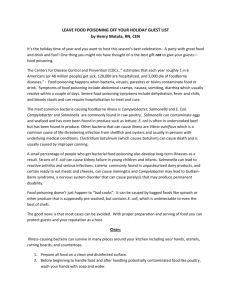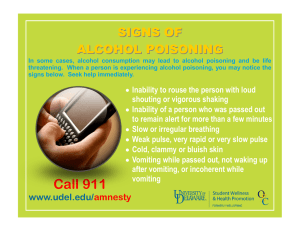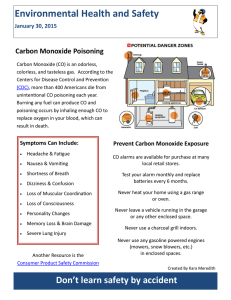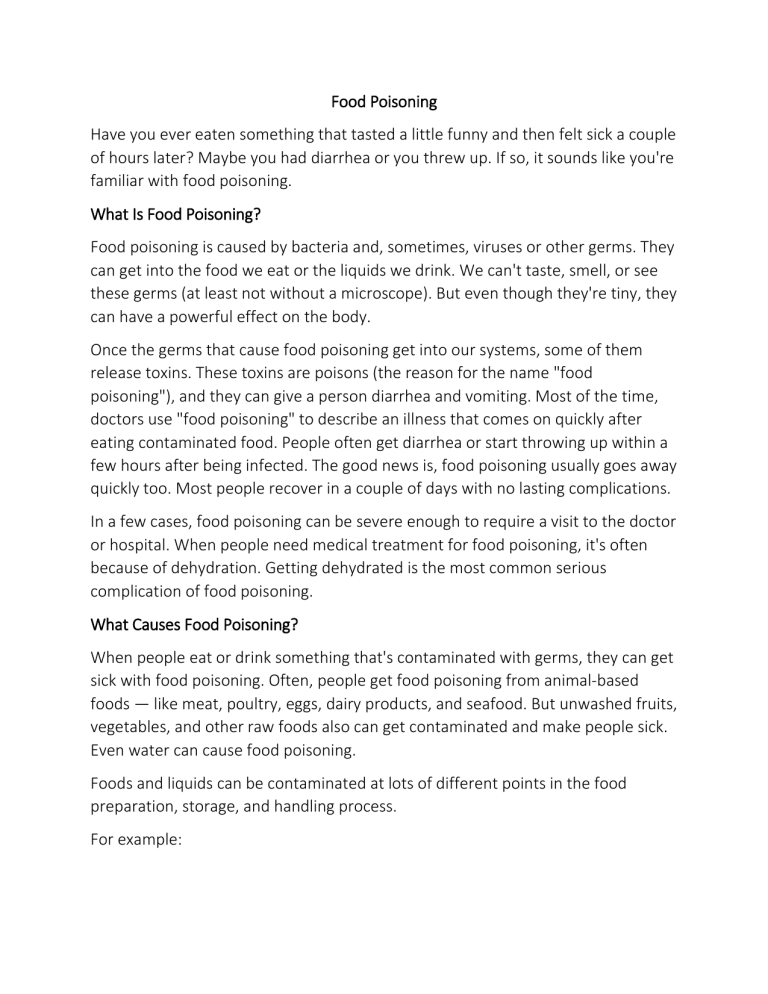
Food Poisoning Have you ever eaten something that tasted a little funny and then felt sick a couple of hours later? Maybe you had diarrhea or you threw up. If so, it sounds like you're familiar with food poisoning. What Is Food Poisoning? Food poisoning is caused by bacteria and, sometimes, viruses or other germs. They can get into the food we eat or the liquids we drink. We can't taste, smell, or see these germs (at least not without a microscope). But even though they're tiny, they can have a powerful effect on the body. Once the germs that cause food poisoning get into our systems, some of them release toxins. These toxins are poisons (the reason for the name "food poisoning"), and they can give a person diarrhea and vomiting. Most of the time, doctors use "food poisoning" to describe an illness that comes on quickly after eating contaminated food. People often get diarrhea or start throwing up within a few hours after being infected. The good news is, food poisoning usually goes away quickly too. Most people recover in a couple of days with no lasting complications. In a few cases, food poisoning can be severe enough to require a visit to the doctor or hospital. When people need medical treatment for food poisoning, it's often because of dehydration. Getting dehydrated is the most common serious complication of food poisoning. What Causes Food Poisoning? When people eat or drink something that's contaminated with germs, they can get sick with food poisoning. Often, people get food poisoning from animal-based foods — like meat, poultry, eggs, dairy products, and seafood. But unwashed fruits, vegetables, and other raw foods also can get contaminated and make people sick. Even water can cause food poisoning. Foods and liquids can be contaminated at lots of different points in the food preparation, storage, and handling process. For example: Water that is used to grow food can become infected with animal or human feces (poop). Meat or poultry may come into contact with infectious microorganisms during processing or shipping. Foods can become infected with bacteria if they're stored at the wrong temperature or kept too long. Cooks or other food handlers can contaminate foods if they don't wash their hands properly or they use unclean utensils or cutting boards when preparing food. People with health conditions (like chronic kidney disease) or weakened immune systems are more at risk of getting ill from food poisoning than people who are in good health. Common Food Poisoning Germs A number of microorganisms can cause food poisoning. Some of the most common culprits are: Salmonella. Salmonella bacteria are the leading cause of food poisoning in the United States. These bacteria usually get into foods when they come into contact with animal feces. The main causes of salmonella poisoning are eating dairy products, undercooked meat, and fresh produce that hasn't been washed well. E. coli (Escherichia coli). E. coli bacteria, too, typically get into food or water when they come into contact with animal feces. Eating undercooked ground beef is the most common reason why people in the United States get E.coli poisoning. Listeria. These bacteria are mostly found in unpasteurized dairy products, smoked seafood, and processed meats like hot dogs and luncheon meats. Listeria bacteria also can contaminate fruits and vegetables, although that's less common. Campylobacter. These bacteria most commonly infect meat, poultry, and unpasteurized milk. Campylobacter also can contaminate water. As with other kinds of bacteria, these usually get into foods through contact with infected Staphylococcus aureus. These bacteria can be found in meats, prepared salads, and foods made with contaminated dairy products. S aureus bacteria can spread through hand contact, sneezing, or coughing. That means the infection can be transmitted by people who prepare or handle food. Shigella. Shigella bacteria can infect seafood or raw fruits and vegetables. Most of the time the bacteria are spread when people who prepare or handle food don't wash their hands properly after using the bathroom. Hepatitis A. People mostly get this virus from eating raw shellfish or foods that have been handled by someone who is infected. It can be hard to pinpoint the source of an infection because people may not get sick for 15 to 50 days afterward. What Are the Signs of Food Poisoning? How food poisoning shows up depends on the germ that caused it. Sometimes a person will start to feel sick within an hour or two of eating or drinking contaminated food or liquid. Other times, symptoms may not appear for a number of weeks. In most cases, symptoms will clear up within 1 to 10 days. Most of the time, someone with food poisoning will notice: nausea (feeling sick) abdominal pain and cramps vomiting diarrhea fever headache and overall weakness In rare cases, food poisoning can make someone feel dizzy, have blurry vision, or notice tingling in the arms. In very rare cases, the weakness that sometimes goes along with food poisoning will cause trouble breathing. Certain types of infectious microorganisms, including Listeria and E. coli, can cause potentially dangerous heart, kidney, and bleeding problems, dizziness, sunken eyes, lightheadedness or weakness. Can I Prevent It? To reduce your risk of food poisoning, follow these tips: Wash your hands thoroughly and often, especially after using the bathroom, before touching food, and after touching raw food. Use soap and warm water and scrub for at least 20 seconds. Clean all utensils, cutting boards, and surfaces that you use to prepare food with hot, soapy water. Don't drink unpasteurized milk or eat food that contains unpasteurized milk. Wash all raw vegetables and fruits that you can't peel yourself. Keep raw foods (especially meat, poultry, and seafood) away from other foods until they're cooked. Use perishable food or any food with an expiration date as soon as possible. Cook all food from animal sources to a safe internal temperature. For ground beef and pork, this means at least 160°F (71°C). For solid cuts of meat, the safe temperature is 145°F. For chicken and turkey (ground and whole), it's at least 165°F (74°C). Cook chicken eggs until the yolk is firm. Fish generally is safe to eat once it reaches a temperature of 145°F (63°C). Refrigerate leftovers quickly, preferably in containers with lids that can be snapped tightly shut. Defrost foods in the refrigerator, a microwave, or cold water. Food should never be thawed at room temperature. If food is past its expiration date, tastes funny, or smells strange, don't eat it. Remember: "When in doubt, throw it out." If you're pregnant, avoid all raw or undercooked meat or seafood, smoked seafood, raw eggs and products that might contain raw eggs, soft cheeses, unpasteurized milk and juice, patés, prepared salads, luncheon meats, and hot dogs. Don't drink water from streams or untreated wells. Adapted from Nemours Teen Health: https://kidshealth.org/en/teens/food-poisoning.html July, 2018

